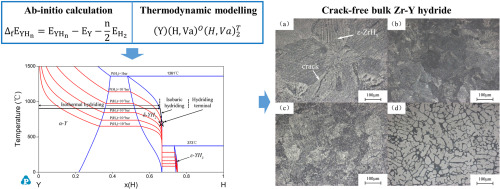Journal of Nuclear Materials ( IF 2.8 ) Pub Date : 2020-01-30 , DOI: 10.1016/j.jnucmat.2020.152035 Jiaqing Peng , Ming Wu , Fu Du , Fengli Yang , Jianyun Shen , Lijun Wang , Xinyu Ye , Guoqing Yan

|
A self-consistent thermodynamic description of Y–H binary system has been derived using the CALPHAD method with the aid of first-principles calculations and applied in the fabrication of crack-free bulk Zr–Y hydride neutron moderator. The enthalpies of formation of the end-members calculated by first-principles were adopted for the thermodynamic assessment. Only four model parameters were needed and optimized with the available experimental data from literature. The calculated phase equilibria and thermodynamic data agree well with experimental data. Y–Zr–H ternary system was constructed by extrapolation of three binary sub-systems. According to the thermodynamic calculation results, the hydrogenation of Zr–Y alloys was divided into three stages: isothermal hydriding, isobaric hydriding and terminal hydriding. By carefully controlling the temperature and hydrogen pressure, the transformation from metal to hydride of yttrium and zirconium can be separated and carried out in different stages, so that the cracks formation during hydrogenation was successfully inhibited. With addition of yttrium, the stress induced by the martensitic transformation from δ to ε zirconium hydride would be relaxed. As a result, hydride embrittlement can be mitigated, and the bulk Zr–Y hydrides without micro-cracks can be fabricated.
中文翻译:

第一性原理辅助的Y–H和Y–Zr–H系统的热力学建模及其在块状氢化物缓和剂制备中的应用
借助第一原理计算,使用CALPHAD方法得出了Y–H二元体系的自洽热力学描述,并将其应用于无裂纹的Zr–Y氢化物中子缓和剂的制造中。通过第一性原理计算的末端成员的形成焓被用于热力学评估。只需要四个模型参数,并使用文献中的可用实验数据对其进行优化。计算的相平衡和热力学数据与实验数据吻合良好。Y–Zr–H三元系统是通过对三个二元子系统进行外推而构建的。根据热力学计算结果,Zr-Y合金的氢化分为三个阶段:等温氢化,等压氢化和末端氢化。通过仔细控制温度和氢气压力,可以分离并在不同阶段进行钇和锆从金属到氢化物的转变,从而成功地抑制了氢化过程中的裂纹形成。随着钇的加入,由马氏体由δ到ε-氢化锆的马氏体转变所引起的应力将得到缓解。结果,可以减轻氢化物脆化,并且可以制造没有微裂纹的大量Zr-Y氢化物。











































 京公网安备 11010802027423号
京公网安备 11010802027423号